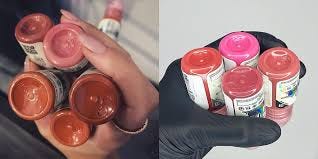Microblading, a popular semi-permanent makeup technique, offers a solution for those seeking to enhance their eyebrows with natural-looking, defined strokes. The success of this procedure largely depends on the quality and selection of microblading pigments used. These pigments are specialized inks designed to replicate the appearance of individual brow hairs, creating a fuller, more defined look. This article explores the composition, types, and key considerations in choosing the right microblading pigments.

Understanding Microblading Pigments
Microblading pigments are a crucial element of the procedure, as they determine the color, longevity, and overall outcome of the brows. Unlike traditional tattoo inks, microblading pigments are formulated specifically for the delicate skin of the face, ensuring a more natural and refined appearance.
Composition and Safety
The composition of microblading pigments is carefully crafted to ensure safety, longevity, and aesthetic appeal. These pigments are typically made from both organic and inorganic compounds.
Inorganic Pigments:
These pigments, often based on iron oxides, are favored for their stability and low risk of causing allergic reactions. They provide earthy, natural tones that are essential for achieving realistic brow colors.
Organic Pigments:
Derived from carbon-based molecules, organic pigments offer more vibrant colors. They are particularly useful for clients seeking a bolder brow look. However, they tend to fade faster than inorganic pigments and may require more frequent touch-ups.
Safety is a top priority in the formulation of microblading pigments. Regulatory bodies such as the U.S. Food and Drug Administration (FDA) and the European Medicines Agency (EMA) set stringent standards to ensure pigments are free from harmful contaminants. Practitioners should always use pigments from reputable suppliers to avoid risks such as infections or adverse reactions.
Types of Microblading Pigments
Microblading pigments come in a range of colors and formulations, each designed to cater to different skin tones and desired outcomes.
Cool Tones:
These pigments are ideal for clients with pink or red undertones in their skin. Cool tones typically include ashy browns, taupe, and gray shades. They help neutralize redness in the skin and provide a balanced appearance.
Warm Tones:
Warm-toned pigments are suitable for clients with yellow or olive undertones. These colors include golden browns, warm chestnut, and honey tones. They complement the natural warmth of the skin and prevent the brows from appearing too harsh.
Neutral Tones:
Neutral pigments can suit a wide range of skin tones, making them versatile options. They include shades like neutral brown and soft taupe. These pigments are often used as a base color that can be adjusted with cool or warm tones as needed.
Modifier Pigments:
Modifier pigments are specialized colors used to adjust the base pigments. For example, a green modifier can be added to neutralize excessive red tones, while an orange modifier can warm up a cool pigment.
Factors Influencing Pigment Choice
Choosing the right microblading pigment involves considering several key factors:
Skin Tone and Undertone:
Understanding the client’s skin tone and undertone is crucial for selecting the appropriate pigment color. A mismatch can result in an unnatural or unflattering appearance. For instance, using a cool pigment on warm-toned skin can create an ashy or grayish look.
Desired Brow Style:
The client’s desired brow style, whether natural and subtle or bold and defined, will influence pigment choice. Lighter, more natural tones are used for soft, natural looks, while deeper, more intense pigments create bolder styles.
Fading Over Time:
Microblading pigments naturally fade over time due to factors such as sun exposure, skin exfoliation, and the body’s immune response. It is important to choose a pigment that will fade gracefully, maintaining a natural look as it lightens.
Allergies and Sensitivities:
Some clients may have allergies or sensitivities to certain ingredients in pigments. Conducting a patch test prior to the procedure can help identify potential issues and prevent adverse reactions.
Longevity and Maintenance:
The longevity of the pigment and the maintenance required are also key considerations. While organic pigments may offer brighter initial results, they may require more frequent touch-ups compared to more stable inorganic pigments.
Advances in Microblading Pigments
The microblading industry continually evolves, with innovations aimed at improving the safety, quality, and longevity of pigments.
High-Definition (HD) Pigments:
HD pigments are designed to provide more vibrant and lasting color. They are formulated to resist fading and offer a consistent appearance over time.
Hybrid Pigments:
Combining the benefits of both organic and inorganic pigments, hybrid pigments offer vibrant colors with improved longevity. They are less prone to fading and provide a natural, balanced look.
Nano Pigments:
Nano pigments consist of ultra-fine particles that allow for more precise and detailed application. They are especially useful for creating fine hair-like strokes in microblading, ensuring a more natural and realistic appearance.
Biocompatible Pigments:
With increasing awareness of health and safety, there is a growing demand for biocompatible pigments that are free from harmful substances. These pigments are formulated to minimize the risk of adverse reactions and are especially beneficial for clients with sensitive skin.
Conclusion
Microblading pigments are a foundational element in achieving beautiful, natural-looking brows. The selection of the right pigment involves understanding the client’s skin tone, undertone, and desired outcome, as well as considering the longevity and safety of the pigments used. As the field of microblading continues to advance, the development of high-quality pigments will enhance the ability to create lasting, aesthetically pleasing results. Whether for subtle enhancements or bold transformations, the right microblading pigment can make all the difference in achieving the perfect brow.


